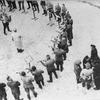4: Photograph, the Janowska concentration camp orchestra, before 1943.
Official camp orchestras were not uncommon in the concentration camp universe. The first publication of “Todesfuge” in 1947 was in Romanian, not in German, in the Bucharest magazine Contemporanul, and, as John Felstiner points out in his book, Paul Celan: Poet, Survivor, Jew, it was accompanied by an editors’ note: “The poem whose translation we are publishing is built upon the evocation of real fact” (p. 28). This assertion was intended to assure readers that the poet had not invented the forced singing and playing of condemned Jews in Nazi camps.
Such orchestras were composed of both amateur and professional musicians and were often formed under order of the camp administrators. One of the most important uses of these orchestras was to coordinate the marching of forced laborers. In addition, music accompanied public punishments and executions to demonstrate the unlimited power of the SS command. In the Janowska concentration camp, the SS commissioned a work called “Todestango” (“Tango of Death”) that the orchestra was required to play during “selections”—when prisoners were chosen to go to the gas chambers—and during public acts of violence and executions. Interestingly, the 1947 Romanian translation of Celan’s poem was entitled “Tangoul Mortii,” meaning “Death Tango.”.
Suggested Activity: Show students the photograph without providing any context and have them do a close reading of it. What do they see? Then, provide them with the context of where and when the photo was taken, and what it depicts. How does this change their perception of the image? What do they notice now that they know it is a concentration camp orchestra?
Next, direct students’ attention back to “Deathfugue.” In the poem, Celan describes the commands of the “man in the house,” beginning with the last line of the first stanza: “he orders us to strike up and play for the dance.” In the next two stanzas, he continues to order the prisoners to “sing up” and “play” in varied ways. Indeed, throughout the poem, the words “orders” and “shouts” precede the words “sing” and “play.” Ask students to contemplate the irony of these juxtapositions, as music, dancing, and play are often signs of celebration, joy, or at least personal expression, rather than the outcome of orders. Ask students to notice how the musical commands shift throughout the poem, becoming darker and more menacing (from “strike up and play” to “play death more sweetly” and “scrape your strings darker”). How does this shift echo the darkening tone of the poem as a whole? Finally, direct students to pay attention to the insistent rhythm and repetition in the poem. What kind of a world does this stern, heavy rhythm evoke?
Source: “Members of the orchestra at the Janowska concentration camp perform while standing in a circle around the conductor, Yacub Mund, in the Appelplatz [roll call area],” United States Holocaust Memorial Museum Collections, United States Holocaust Memorial Museum, Apr. 4 2019, https://collections.ushmm.org/search/catalog/pa10008.

